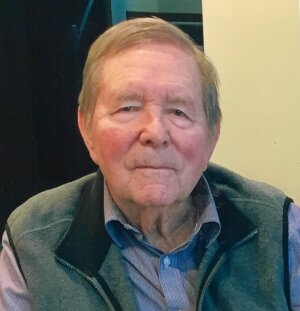 Lewis E. Snyder (Photo courtesy of University of Illinois)
Lewis E. Snyder (Photo courtesy of University of Illinois)
Lewis Emil Snyder
Contributed by Anthony Remijan and Philip R. Jewell
Lewis (Lew) Emil Snyder died at his home on 3 February 2021 at the age of 81. Snyder was a pioneer in the field of molecular astrochemistry and provided scientific motivation for the modern generation radio observatories such as ALMA.
In 1969, as an NRAO scientist, Snyder led a research team that discovered the formaldehyde molecule (H2CO) in the interstellar medium using the 140-Foot Telescope in Green Bank. This was the first polyatomic molecule detected in space that contained more than a single heavy atom, and demonstrated that complex molecules could form and persist in space. Prior to this discovery, only inorganic species had been detected consisting of hydrogen atoms and single heavy atom (carbon, oxygen, or nitrogen).
The detection of interstellar formaldehyde forever changed the landscape of astronomy and started the new science of astrochemistry. As Snyder stated in his detection paper:
"The detection of interstellar formaldehyde provides important information about the chemical physics of our galaxy. We now know that polyatomic molecules containing at least two atoms other than hydrogen can form in the interstellar medium. Their formation apparently does not require extremely unusual interstellar conditions since we detected H2CO in clouds at various distances between earth and the background radio sources.... Hence large regions of the galaxy may be filled with clouds containing formaldehyde.... This evidence coupled with the recent discovery of ammonia in the galactic center and water in several sources indicates that processes of interstellar chemical evolution may be much more complex than previously assumed."
Since this discovery, well over 200 distinct molecules have been detected in a variety of astronomical environments, ranging from the first molecular gas produced in the most distant galaxies, to molecular clouds and star formation regions in our own Galaxy, to the atmospheres of moons around the major planets. In 50 years of molecular discovery, the rate of new molecules discovered in astronomical environments has stayed nearly constant at about four new molecule detections per year, largely attributable to Snyder's pioneering work. Snyder was responsible for about 20 astronomical detections of new molecules, including the significant diagnostic molecules HCO+ and HNC, and 150+ publications over the course of his career.
In addition to his work on detecting new astronomical molecules, Snyder characterized the range of molecules in the interstellar medium, was one of the first researchers to recognize the possibility of biologically-significant molecular species in interstellar space, and revolutionized our understanding of the chemical complexity of cometary comae. Snyder was also an expert in the application of interstellar maser emission as an astrophysical diagnostic, and was responsible for the first detection of the interstellar silicon monoxide (SiO) maser.
In 1983, Snyder was a member of the NSF committee chaired by Prof. Alan Barrett that recommended the construction of a U.S. national millimeter / submillimeter array. This recommendation was adopted as the MMA project, which eventually merged to form the international ALMA Observatory project. Snyder was one of the first directors of BIMA, a millimeter-wave array and precursor of ALMA, jointly operated by the University of California Berkeley, University of Illinois, and the University of Maryland.
After leaving NRAO, Snyder held faculty appointments at the University of Virginia and, for over 30 years, as a professor at the University of Illinois. He also held appointments at the University of Colorado and at the Max-Planck-Institut füur Radioastronomie in Bonn, Germany. Snyder mentored dozens of students, postdocs, and early-career faculty and scientists, many of whom are still actively working in the field of astrochemistry. Lew Snyder's pioneering contributions to astronomy, his commitment to expanding our knowledge of the chemical understanding of the universe, and his contributions to the next generation of scientists form a lasting legacy.
The Lewis E. Snyder Astrochemistry Award is presented yearly at the International Symposium on Molecular Spectroscopy in recognition of Lew's commitment to expanding our knowledge of the chemical understanding of the Universe and to developing the next generation of scientists dedicated to building a scientific literate community.
![[IAU logo]](iau_wb_thumb.jpg)
![[URSI logo]](URSI-logo-thumb.jpg)
![[Karl Jansky at his antenna]](jansky_photo_02_thumb.jpg)
![[Reber's Wheaton antenna]](Reber_Telescope_Wheaton_thumb.jpg)
![[Dover Heights]](Dover_Heights_02_thumb.jpg)
![[4C telescope]](GB61-195_4C_telescope_thumb.jpg)
![[Ewen and horn antenna]](ewen_horn1s.jpg)
![[Dwingeloo, 1956]](Dwingeloo-1956-thumb.jpg)
![[Jocelyn Bell Burnell and Cambridge antenna used in pulsar discovery]](burnell2_thumb.jpg)
![[Lovell Telescope at Jodrell Bank]](site_1594_0001-500-334-20180316163019-thumb150.jpg)
![[Wilson, Penzias, and Bell Labs horn antenna]](wilson-penzias-horn_thumb.jpg)
![[6-m Millimeter Radio Telescope in Mitaka, Japan]](6m-thumb.jpg)

